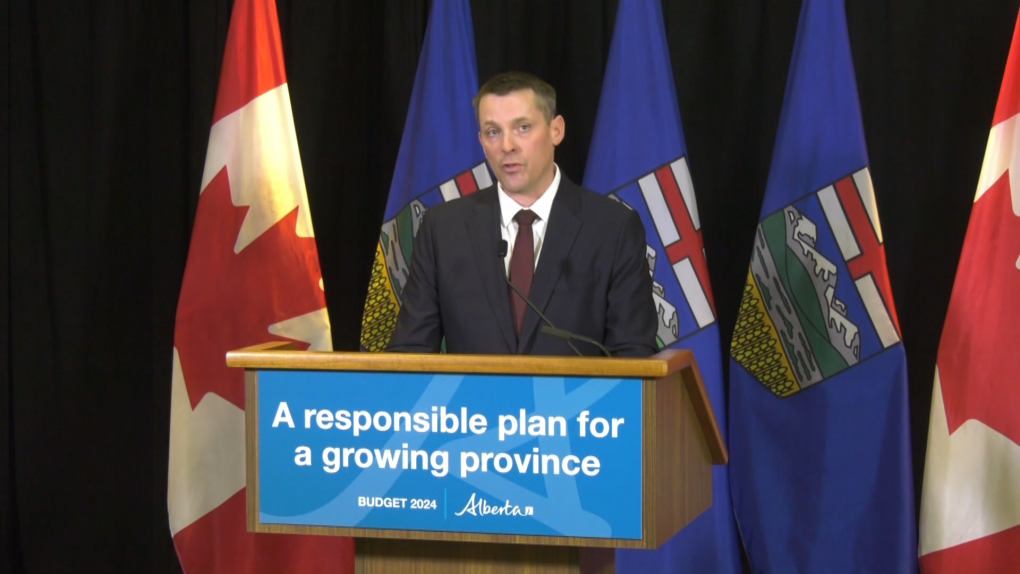Alberta government reports $367M surplus as it takes on debt to fund capital projects

Deficit free, cash poor.
That’s the position the Alberta government is in Thursday as it tables the province’s budget for another year.
Finance Minister Nate Horner presented the details to the legislature of the $73.2-billion price tag for the annual plan, which promises to increase spending for health care and education, which together make up 61 per cent of it, by 4.4 per cent as well as resource management and capital construction while forecasting a surplus of $367 million for the 2024-25 fiscal year.
The budget also includes $2 billion moved to the Heritage Savings Trust Fund from the government’s Alberta Fund, a surplus cash reserve created last year that’s allotted for deposits into the Heritage Fund, debt repayment or one-time discretionary initiatives that do not create future spending increases.
The Heritage Fund, which now has a market value of $25 billion, retains $1.38 billion in earnings. Premier Danielle Smith last week pledged to bolster the fund created by the Lougheed PC government in 1976 to invest Alberta royalty revenues into savings that’s been used by several administrations since to balance budgets.
Among the sectors requiring substantial annual funding from the provincial government, health care will see its operating costs increased in 2024-25 to $26.2 billion, while primary and secondary schools will receive a record $9.3 billion for operations.
Alberta has also pledged $25 billion in capital funding to build schools, hospitals and infrastructure projects.
But while officials say the province is in a negative cash position, it’s technically not running a deficit. It is, however, borrowing $2.4 billion to balance the budget.
Horner told media prior to Thursday’s speech in the legislature that the lower-than-expected surplus — which came in $2.1 billion less than estimated in his fiscal update in November — came from a combination of factors including increased debt servicing costs, contingent needs and the effects of a population increase.
“It’s a number of things, but we could definitely see it coming,” Horner said. “We knew Budget 2024 was going to be far more difficult.”
Horner said when the government leaves “retained earnings in the Heritage Fund or with these other agencies,” it will become more commonplace.
“It will require bigger surpluses to have more cash,” he said.
“Really, the big cash requirement is for the capital plan.”
Horner said the “easiest way” to explain why the government is borrowing money to cover the budget while reporting a surplus is “that we’re choosing to, somewhat.”
“We could have left the retained earnings in the Heritage Fund and had those in general revenue, then we probably wouldn’t have been in a position where we would’ve chosen to make that deposit because things are so tight,” he said.
“We’re making the choice to leave it there, and it causes us to need the cash at the end of the year for our cash position. If I’d ask Albertans to think of it that way, it’s about choices we’re making between debt they’re willing to take on and savings that they want to make probably because they see that value in the returns and the long-term vision.
“I imagine there are Albertans that have savings that could eliminate all their debt, but they choose not to because the savings have that value for them and they know what that will mean in the future.”
Personal tax cut delayed
A personal tax cut promised by the UCP during last year’s provincial election is slated to begin in 2026.
For it, income up to $60,000 will be taxed at a rate of nine per cent, a rate that will drop to eight per cent the following year. The cut, which is contingent on the province having the fiscal capacity to implement it, is projected to save 2.2-million residents up to $760 each.
Opposition NDP Leader Rachel Notley criticised Premier Danielle Smith for failing to follow through with the cuts right away calling the government’s recent overtures to shore up the Heritage Fund “a short-term investment” to distract residents from the lack of a cut.
“We could all tell in the last election that that tax cut was going to be tough to handle, tough to fund, but we didn’t make that promise to Albertans, she did,” Notley told media at the Alberta legislature following the tabling of the budget.
“Now what she’s done is she’s broken it. This whole moving around have a pretend surplus and a pretend investment into the Heritage Trust Fund while creating a larger debt, it’s just that. It’s showmanship to distract from a broken promise.”
Budget highlights
- The province’s revenue target for 2024-25 comes in at $73.5 billion, $2.1 billion lower than expected last year in its fiscal update. It’s partly based on the estimated price of oil staying at $74 a barrel for from 2024 to 2026.
- The province’s total taxpayer-supported debt comes in at $78.4 billion. The Alberta government will borrow $20 billion in 2024-25 to fund capital projects and service debt.
- Included in health-care spending is $6.6 billion to pay doctors — an increase of $500 million — $4.4 billion for acute care, $475 million for primary care, $1 billion over three years for continuing care and $126 million over three years for rural physician expansion.
- $1.5 billion for child-care services, an increase of $200 million.
- $1.9 billion for school capital projects over the next three years, including $681 million in new funding for 43 projects earmarked to create 35,000 new or modernized student spots.
- Mental health and addiction services will receive $1.13 billion in 2024-25.
- The province is allocating $3.6 billion over three years for health capital projects.
- $1.3 billion in capital funding over the next three years for water management and drought preparedness.
- $1.2 billion to cover operating expenses for public safety and emergency services, including police and mental health crisis teams.
- $151 million over the next three years for enhancements to the wildfire management program and $55 million for wildfire capital funding for equipment and facilities..
- The finance ministry forecasts surpluses of $1.4 billion for 2024-25 and $2.6 billion in 2025-26.
View original article here Source









